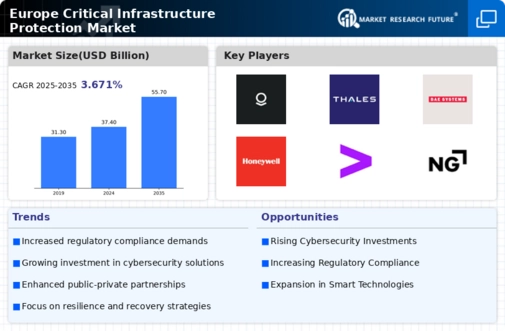Focus on Sustainability
The critical infrastructure-protection market in Europe is increasingly intertwined with sustainability initiatives. As environmental concerns gain prominence, there is a growing emphasis on developing infrastructure that is not only secure but also environmentally friendly. The European Green Deal aims to make Europe the first climate-neutral continent by 2050, which necessitates the integration of sustainable practices in infrastructure development. This shift is likely to drive demand for innovative solutions that address both security and environmental challenges. Companies that can offer sustainable protection measures are expected to gain a competitive edge in the critical infrastructure-protection market.
Rising Threat Landscape
The critical infrastructure-protection market in Europe is influenced by a rising threat landscape, characterized by a surge in cyberattacks and physical threats. Recent data indicates that cyber incidents targeting critical infrastructure have escalated by over 30% in the past year alone. This alarming trend compels organizations to invest in advanced security measures to safeguard essential services. The European Union has recognized this urgency, allocating approximately €1 billion towards enhancing cybersecurity frameworks across member states. As threats evolve, the critical infrastructure-protection market must adapt, leading to a heightened demand for innovative solutions that can effectively mitigate risks and ensure the resilience of vital systems.
Technological Advancements
Technological advancements play a pivotal role in shaping the critical infrastructure-protection market in Europe. The integration of artificial intelligence (AI), machine learning, and the Internet of Things (IoT) is revolutionizing how organizations approach security. For instance, AI-driven analytics can predict potential vulnerabilities, allowing for proactive measures. The market for AI in cybersecurity is projected to reach $30 billion by 2026, reflecting a growing recognition of its importance. Furthermore, the adoption of smart technologies in infrastructure management enhances monitoring capabilities, thereby improving response times during incidents. As these technologies continue to evolve, they are likely to drive significant growth in the critical infrastructure-protection market.
Evolving Regulatory Landscape
The evolving regulatory landscape significantly impacts the critical infrastructure-protection market in Europe. With the introduction of stringent regulations aimed at enhancing security protocols, organizations are compelled to comply with new standards. The EU's NIS Directive, which mandates improved cybersecurity measures for essential services, exemplifies this trend. Compliance costs are projected to rise, with organizations potentially facing fines of up to €10 million for non-compliance. This regulatory pressure is likely to drive investments in security technologies and services, thereby propelling growth in the critical infrastructure-protection market as companies strive to meet these new requirements.
Increased Investment in Resilience
Investment in resilience is becoming a critical driver for the infrastructure-protection market in Europe. Governments and private entities are recognizing the necessity of fortifying their infrastructure against both natural disasters and man-made threats. Recent reports suggest that public spending on infrastructure resilience is expected to increase by 25% over the next five years. This trend is particularly evident in sectors such as energy and transportation, where the need for robust protective measures is paramount. As organizations allocate more resources towards resilience, the critical infrastructure-protection market is likely to experience substantial growth, driven by the demand for comprehensive risk management solutions.


















Leave a Comment